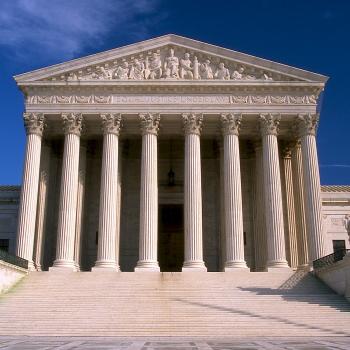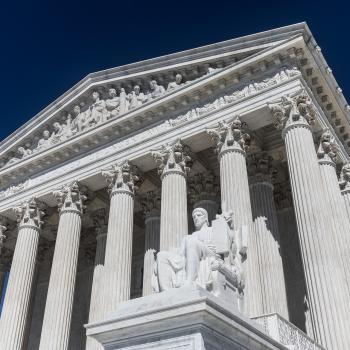Forbid Them Not, 318-340
This week is the hearing before the Virginia Supreme Court. I’m going to try to be concise and to skip sections that are simply a repetition of the previous hearing. If you’re not interested in the details, skip down to the end, where I’ve added some information under a bold header.
Randolph goes first. The justices ask him about what gives the Children’s Defense Fund and National Education Association standing to bring this lawsuit. That goes on for a while, all of it repetitive.
The justices next turn to something more practical:
“Article 13 of the Convention,” Wilhoite began, “guarantees children the right to receive and impart ‘information and ideas of all kinds.’ Let’s consider an example where a child wants to receive explicit information about homosexuality and his parents don’t want him to do that. Do you interpret this treaty to say that the child would have the final say on this question?”
“No, Your Honor. The child would not have the final say.”
Wilhoite brightened. “You mean the parent would have the final say?”
“No, that wouldn’t be accurate either,” Suskins replied.
“OK, then, will you tell me how it should work? Wilhoite asked.
“In the case of a dispute of this nature between the child and the parent, it would be the responsibility of the decision maker to weight the parents’ concerns and the child’s desires and make a decision that is in the best interest of the child.”
“Who would the decision maker be?” Wilhoite continued.
“Normally, it would be the child’s social worker, I would imagine, Your Honor.”
“How does the child get a social worker?”
“Under the Convention, every child has immediate access to a social worker for the implementation of the child’s rights under the treaty,” Suskins replied, with a thin smile.
“So what you are telling us, Counsel, is that the real decision makers in ordinary family disputes are social workers? Mom and Dad no longer have the final say then?”
“Well, you could say that. We prefer to focus on the social workers as guarantors that the decisions made by the parents are, in fact, in the best interests of the child.”
Let’s be clear: This is not a discussion of what the UN Convention on the Rights of the Child (CRC) would actually do. This is a discussion of what Farris claims the CRC would do. What makes this odd is that he’s putting it in Randolph’s mouth. In other words, this is Farris’ exposition on what Farris claims the CRC would do—but coming from a proponent of the treaty.
This is not how the treaty functions in any country that has ratified and implemented it. Consider the assertion being made here: That every country in the world has social workers reviewing any parental decision children disagree with. Um, no. That is not the case. What is more reasonable? That countries are not implementing it correctly? Or that Farris has it interpreted incorrectly?
It’s worth restating what Article 13 actually says:
Article 13
1. The child shall have the right to freedom of expression; this right shall include freedom to seek, receive and impart information and ideas of all kinds, regardless of frontiers, either orally, in writing or in print, in the form of art, or through any other media of the child’s choice.
2. The exercise of this right may be subject to certain restrictions, but these shall only be such as are provided by law and are necessary:
(a) For respect of the rights or reputations of others; or
(b) For the protection of national security or of public order (ordre public), or of public health or morals.
That statement about public health or morals is key. In many countries that have ratified the CRC, homosexuality is still banned. In these countries, children most certainly do not have access to information about sexual orientation. If the U.S, were to ratify the CRC and to argue that every child should have access to information about sexual orientation, the issue would not be so much the treaty as what our society in the aggregate had determined about public health and morals.
How the CRC is interpreted and implemented varies from country to country, conforming with that country’s values and customs. This is not at all in keeping with Farris’ insistence on viewing the CRC as something imposed from without rather than something negotiated within.
Okay. Moving on!
Randolph argues that the CRC is self-executing. That means that no law from either state government or Congress is necessary for them to be in effect. This is why Rick and Deanna and Jeanne and Doug can be sued, even in the absence of any laws by any governmental body to implement the provisions of the treaty under which they are being sued.
“By the very terms of the treaty, the UN committee is given the ultimate authority to determine its meaning. American courts would be required to follow its interpretations on a principle similar to the Full Faith and Credit Clause.”
A lot of this discussion is based on the idea that the U.S. gave up a certain amount of its sovereignty when signing the CRC. One problem is that the UN doesn’t send in troops to enforce the CRC in countries that have ratified it. Randolph cites cases where the Committee on the Rights of the Child informed Belgium, Austria, and Canada that spanking is illegal under the CRC and that they must therefore ban it. This is all well and good, except that spanking is still legal in Canada.
“Your honor, there have been numerous decisions by the Committee on the Rights of the Child that have repeatedly held that spanking is banned by the terms of the treaty. Decisions against Belgium in June of 1995, Austria and in 1999, and Canada in May of 1995—just to name three—all concluded that spanking is illegal under the direct terms of the treaty.”
I managed to find the “decision against Canada“:
The Committee suggests that the State party examine the possibility of reviewing the penal legislation allowing corporal punishment of children by parents, in schools and in institutions where children may be placed. In this regard and in the light of the provisions set out in articles 3 [on states’ responsibility to pass laws implementing the CRC] and 19 [on protection from violence] of the Convention, the Committee recommends that the physical punishment of children in families be prohibited. In connection with the child’s right to physical integrity as recognized by the Convention, namely in its articles 19 [on protection from violence], 28 [on schools] and 37 [on prisons], and in the light of the best interests of the child, the Committee further suggests that the State party consider the possibility of introducing new legislation and follow-up mechanisms to prevent violence within the family, and that educational campaigns be launched with a view to changing attitudes in society on the use of physical punishment in the family and fostering the acceptance of its legal prohibition.
The Committee recommends. The Committee further suggests.
All of this is stated as a recommendation—a recommendation Canada did not follow, by the way, and with no adverse consequences. Don’t get me wrong—I’m opposed to spanking and wouldn’t object to it being banned (provided that any ban is accompanied with education). My point, though, is that the Committee on the Rights of the Child does not have any way of sanctioning countries that do not implement its recommendations—and all it does is recommend.
Justice Schwartz breaks in to point out that in each of these cases, the Committee urged the country to create a law making spanking illegal. Wouldn’t the U.S. have to pass a law, too, rendering this court case premature? Randolph says things are different in the U.S. because we have a provision in our Constitution that makes treaties the highest law of the land:
“When Belgium, Austria, and Canada ratify a treaty, they have created a moral obligation to comply with the treaty. But in the United States our Constitution specifically says that a ratified treaty is the highest law of the land … Because of that provision of American law, virtually all of this treaty is automatically applicable without the need fo new legislation…”
Literally none of this makes sense.
I looked up interpretations of the Supremacy Clause because this does not actually sound like something Randolph would argue. I found a motherlode. I’m going to run through the rest of this hearing quickly, and then turn to what I turned up. All you need to know at this point is that none of this is in line with current interpretation of the Supremacy Clause. The only thing it’s in line with is HSLDA’s interpretation. Or in other words, Farris’s interpretation. No, really. It’s not even the prevailing conservative legal opinion! I’ll get to this in a moment—first, let’s finish this hearing.
Randolph claims that the Committee told Great Britain in 1995 that children could not be withdrawn from sex education classes without government officials reviewing “the parental request to opt out of sex education to determine whether such a request was in the best interests of the child,” and that the Committee also held that any time a parent withdrew a child from public school to enroll them in private school, this decision had to be “reviewed by government agencies that are given the task of reviewing the decision for the best interest of the child.”
This is simply not what the Committee’s 1995 response to Great Britain said at all. Here is what it actually said:
In relation to the implementation of article 12, the Committee is concerned that insufficient attention has been given to the right of the child to express his/her opinion, including in cases where parents in England and Wales have the possibility of withdrawing their children from parts of the sex education programmes in schools. In this as in other decisions, including exclusion from school, the child is not systematically invited to express his/her opinion and those opinions may not be given due weight, as required under article 12 of the Convention.
…
With regard to matters relating to education, the Committee suggests that children’s right to appeal against expulsion from school be effectively ensured.
That’s it. I can’t find anything else at all that would seem to pertain to Randolph’s claims. That bit about expulsion isn’t about kids being withdrawn from public school to be enrolled in private school—it’s about kids who are expelled. Farris, through Randolph, is lying.
Next it’s Cooper’s turn. Cooper argues that the entire treaty is unconstitutional, “if we are to follow original intent of the Constitution.” This is because the Founding Fathers only knew of treaties as things that “control trade, boundary line issues, and matters such as fishing regulations on the high seas,” and not things that “control family life, spanking, church searches, and the like.”
“They would have said that such a treaty was unconstitutional because it violated the very premise of America as a sovereign nation. There is fundamentally no difference between allowing an unelected king of England to decide policy decisions for America and letting an unelected group of ten people in Geneva, often meeting behind closed doors, to decide policy questions for America. If we are going to keep our self-government, we must keep our sovereignty. Americans should be the only ones who make laws for America.”
Um. Actually. There’s a pretty big difference. The Committee, as I said, does not have an army. It does not have any way to enforce its recommendations. That is simply not how it works. I’m wondering—does Farris also object to the U.S. having signed the Geneva Convention?
As in the previous hearing, a judge—Justice Vanderleigh this time—tells Cooper that that speech belonged in the Senate, during the ratification process, and not here in this courtroom.
“Unless you can cite a case in which the U.S. Supreme Court has ruled that a treaty that controls domestic policy is unconstitutional, I am afraid that we have no ability to accept your argument. Is there such a case?”
And then there’s this weird bit:
“I rely only on the fundable principles of our nation and have to concede that the treaty process has been used in recent decades for the control of domestic political matters. But just because the Constitution has been repeatedly violated does not make it right. Segregated schools were the practice for generations, but eventually the courts said the words of the Constitution require a different result. That is what I am asking for here.”
I don’t know, I tend to think Farris is probably the kind of guy who would have supported states’ right to run segregated school systems. Regardless, Justice Vanderleigh repeats this is the wrong court to be arguing this in. So Cooper moves on. He argues that private agencies should not be able to bring a suit like this. This is all regurgitated from the previous hearing, and it’s boring.
Cooper argues that the treaty is not self-executing. When questioned about spanking, he says that if the Committee in Geneva could rule that other countries needed to pass legislation to ban spanking, the same was true in the U.S.: “If the decisions of the Geneva committee are binding about some issues, then the court must treat the committees decisions as binding about all issues.” Justice Schwartz asks about Randolph’s Supremacy Clause argument—his claim that the treaty is self-executing in the U.S. because the Constitution names treaties are the highest law of the land.
“How do you answer Mr. Suskins’ point, Counsel?”
Cooper spoke deliberately. He had faced this question in his oral argument preparation. He had asked God to reveal a supernatural answer to him if there was one. Nothing came to his mind.
“I have no answer at the present time, Your Honor.”
Here is the problem—Cooper is arguing something that he (and by proxy, Farris) does not actually believe. Farris believes the treaty is self-executing. That’s why he says the U.S. should not ratify it. So here, now that it’s ratified, we have the opposition lawyer arguing that the treaty is self-executing and Farris (I mean Cooper) trying to come up with something—anything—to say.
Justice Schwartz goes on to suggest that the treaty may indeed invalidate all private school law in the U.S. Cooper argues that even if the treaty were to require new laws to be written on private education, private education could not be banned in the interim, because it was protected by Pierce v. Society of Sisters, a 1925 Supreme Court decision that struck down a state ban on private education. Cooper argues that if the current laws must be replaced, that should happen in the regular manner, and that therefore “this case is premature.”
And then there’s this weird bit:
“One of the most important religious questions ever to be answered is this one: Where did man come from? That question affects the entire system of beliefs about the nature of man and the nature of God. Yet, our public schools for years have taught only one view on this. Evolution is the truth, we are told. Why is this not poisoning their minds? Why are children not given freedom of choice on this topic? Why hasn’t the Children’s Defense Fund brought this question before the Court? If the principle is that adults cannot influence the beliefs of children, then it will be impossible for adults to teach schools.”
“Actually Counsel, won’t the rule be,” Justice Schwartz asked, with a somber look on her face, “that adults who disagree with the UN won’t be allowed to influence the beliefs of children in a contrary fashion. If you agree with the UN, you can ‘poison’ children’s minds with impunity.”
Again, I’m fairly sure that Farris would argue, if he could, that evolution should not be taught in public schools at all. This “teach both sides” thing is a fallback position.
Also, what is with Justice Schwartz? And she’s a female justice? This is just weird.
Now we return to Randolph for his rebuttal. He focuses on the issue of what can be taught in Sunday School:
“We contend simply that neither hate nor intolerance are true Christianity, nor are they protected by the U.S. Constitution.”
What in the blazes?
“Hate crimes have been outlawed in this country for some time.”
Well yeah, but that’s action—that’s not belief.
“Parents may have the religious freedom to teach love, but the freedom to teach hate is not a value that has been enshrined in our Constitution.”
I guess I don’t remember the part where the Constitution breaks things down like this.
The chief justice thanks both parties:
“Counsel, the case was well briefed and well argued. I don’t mind saying that a historic case of this nature requires superior advocacy, and you both have done your jobs with excellence.”
Again?? This just sounds like puffing.
Now, this is the interesting part!
In googling the Supremacy Clause I came upon an article in the William & Mary Bill of Rights Journal that offers a whole lot of context I have never heard before.
First, this:
The origins of the federal government’s treaty-making power—and indeed, the Supremacy Clause—date back to the pre-Revolutionary period. … The Articles of Confederation placed the power to create treaties in the hands of the federal government to the exclusion of the several states. However, though the power to treat with foreign nations was given solely to the Continental Congress, the federal government did not have an enforcement mechanism against the states to ensure that the individual states’ laws complied with American commitments abroad. Thus the states often flaunted treaty provisions and failed to enforce treaties against their citizens. Because of the lack of enforcement provision as against the states, Congress could do little more than beg them to comply with the country’s contracted international obligations. It was clear to many of the Framers that if the United States were to succeed as a nation, it would have to give the federal government leave to create treaties and to enforce them. As Supreme Court Justice Joseph Story asserted, “The peace of the nation, and its good faith, and moral dignity, indispensable require, that all state laws should be subjected to [the] supremacy [of treaties].” Thus, the Supremacy Clause was introduced into the debate over the new Constitution.
That, then, is the reason the Supremacy Clause was created: It was because the new nation involved separate state governments being ruled by a federal body. This was different from most other countries, and it had created problems, with states refusing to abide by treaties (on things like trade, etc.). That was the problem this was meant to solve.
But things didn’t end there. Farris hasn’t mentioned any of what actually came next, but the William & Mary article covers it in some detail:
Originally, the Court upheld the Framers’ intended purpose of the Supremacy Clause by holding that treaties became part of the corpus of American law upon ratification by the Senate. However, this precedent was set aside some fifty years after the ratification of the Constitution with Chief Justice Marshall’s holding in the 1829 case of Foster v. Neilson. Foster considered ownership of land ceded by Spain to the United States by treaty. The Court ruled that there were two distinct types of treaties: those which became law upon their ratification, and those which “import a contract, whe[re] either of the parties engages to perform a particular act, the treaty addresses itself to the political, not the judicial department; and the legislature must execute the contract before it can become a rule for the Court.”
The Court ruled that there were two distinct types of treaties.
In other words, since 1829, the courts have held that some international treaties are self-executing and others are not. Since 1829. Why the blazes has no one mentioned this?! It would seem to be important! The only guess I have is that Farris doesn’t think this was valid—he thinks the courts were wrong—and he doesn’t want his hero basing arguments on jurisprudence he thinks is wrong.
Let’s go on—how did the courts distinguish between the two types of treaties?
Under the doctrine created by Foster, those treaties which “address [themselves] to the political . . . department[s]” require implementing legislation in order to become the supreme law of the land. However, the distinction (and its associated test) was inconsistently applied by the Court in the Nineteenth Century. The general trend, as expressed by the Restatement (Third) of Foreign Relations, was to hold treaties to be self-executing—that is, as the supreme law of the land—unless the treaty itself contained language to the contrary.
Okay. How does this apply to the CRC? Does the CRC treat itself as self-executing, or does it suggest that laws need to be made to implement it? Let’s look at Article 19, the one that is applied to discussions of corporal punishment:
Article 19
1. States Parties shall take all appropriate legislative, administrative, social and educational measures to protect the child from all forms of physical or mental violence, injury or abuse, neglect or negligent treatment, maltreatment or exploitation, including sexual abuse, while in the care of parent(s), legal guardian(s) or any other person who has the care of the child.
2. Such protective measures should, as appropriate, include effective procedures for the establishment of social programmes to provide necessary support for the child and for those who have the care of the child, as well as for other forms of prevention and for identification, reporting, referral, investigation, treatment and follow-up of instances of child maltreatment described heretofore, and, as appropriate, for judicial involvement.
I don’t know about you, but that seems pretty explicitly not self-executing to me. The CRC is full of language like this.
Oh and by the way, in Medellin v. Texas (2008), Thomas, Scalia, Alito, Kennedy, and Roberts held that 70-odd human rights treaties signed by the U.S. were in fact not self-executing, and that decisions of the International Court of Justice were not binding on the U.S. Yes, this happened after Farris wrote this book. But frankly, Farris’ fear-mongering on the CRC hasn’t ceased.
In that 2008 case, by the way, three of the court’s liberal justices ruled that these treaties were self-executing. If that were the case—if it is the conservative view that treaties like these are not self-executing and the liberal view that they are—Farris could have told that story. But in having his star player slack-jawed when pressed to respond to this argument, Farris does not even reveal that there is a real and present robust argument that some treaties are not self-executing.
This is nuts.
Even the William & Mary article states directly:
The argument that the Convention [on the Rights of the Child] would be self-executing is not supported by all scholars, and indeed it runs against the general presumption that human rights treaties are not, and were not under the pre-Medellín standard, self-executing.
What is actually going on here? Well, if the CRC wouldn’t be self-executing, it wouldn’t be as scary. By claiming it would be self-executing and offering none of this legal background, Farris can keep his base scared. Why wouldn’t he want the treaty to be ratified, even if it isn’t self-executing? Because it says children have rights, that’s why. One of Farris’ big goals is the passage of a federal parental rights amendment. Parents have rights. Children don’t. Parents decide. Children don’t.
Farris has his reasons for wanting to keep his base opposed to the passage of the CRC. Unfortunately, those reasons have made this book effectively moot as an educational tool. This book is not an exploration of the Constitution and international law. It’s base propaganda.
I promise, next week will be more interesting! Next week, Laura pops back in the picture, and it’s everything you’ve been waiting for!
I have a Patreon! Please support my writing!















